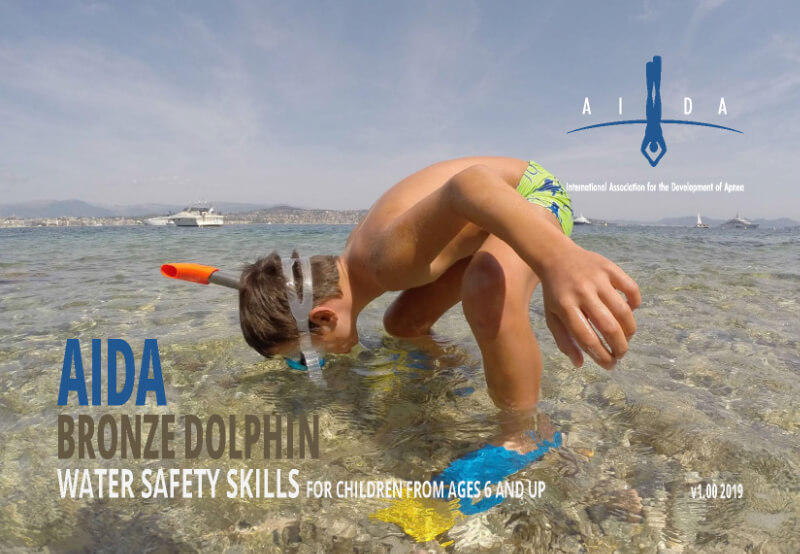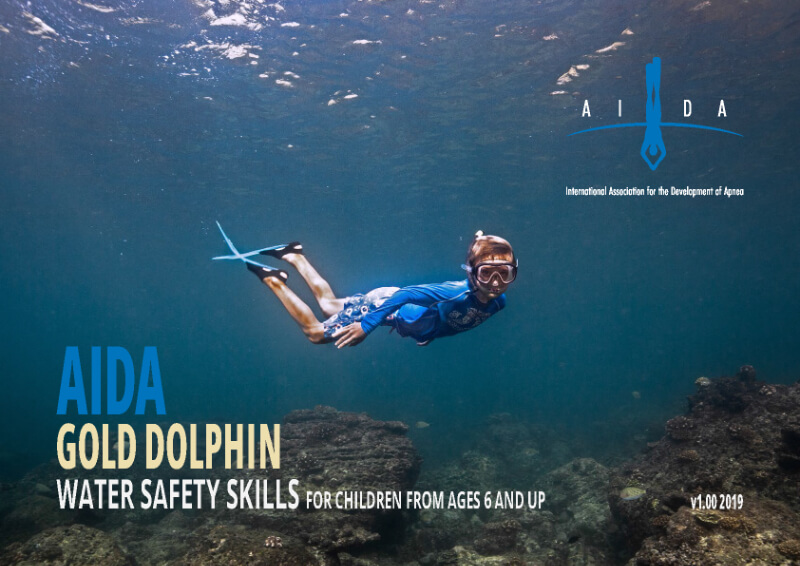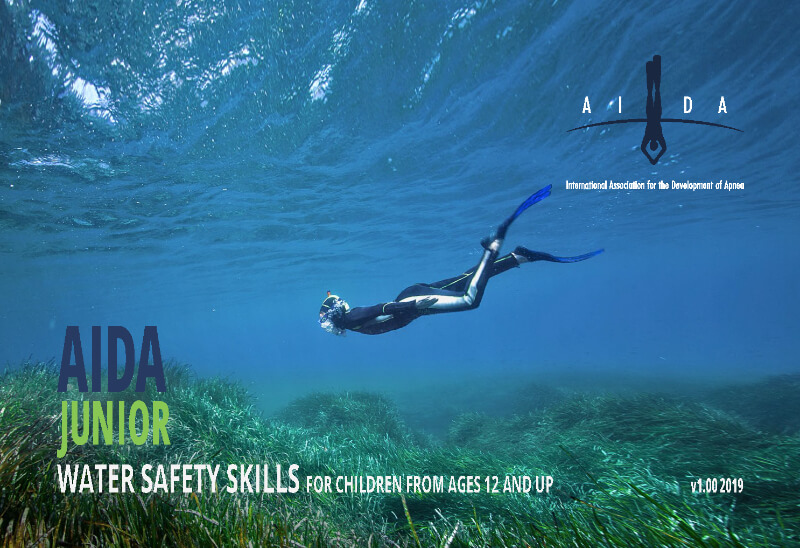Youth courses
Back to courses!
The AIDA Youth Education System is focused on mastering of water familiarisation skills, enjoyment of the aquatic environment, coordination and general health and wellbeing.
Bronze Dolphin
Silver Dolphin
Gold Dolphin
AIDA JUNIOR
AIDA 2
EMPATHIC APPROACH
The quality of a child’s in-water experience is very important for their future relationship with water. Students’ complaints about discomfort or pain, as well as their communication of fear should never be ignored, and adequate support must always be provided.
The AIDA Youth Program apply games involving submersion that can help acquire and master concepts and water skills. The games are focusing on technique or problem solving for example collecting toys from the bottom instead of encouraging competition between the kids.
The AIDA Youth Program intentionally does NOT introduce some of the concepts that are at the basis of all existing AIDA courses for adults. This is to evade a performance-oriented approach and encourage a process and skill-oriented focus. These exercises help assess water skills and improve water confidence in beginner swimmers. All games/ exercises are done in shallow water.

THE OBJECTIVES OF AIDA YOUTH EDUCATION
Safety of the students is the first concern of the AIDA Youth Instructor
Develop aquaticity as familiarity interacting with water
Develop specific qualities and skills that will help AIDA Youth alumni become competent freedivers in the future as young adults
GENERAL APPROACH
Safety of the students is the first concern of the AIDA Youth Instructor
A non-competitive atmosphere and mind-set
Paying close attention to physical and psychological comfort of young students
Teaching water skills in connection with environmental awareness
Assuring that parents/guardians understand the safety rules and post-course supervision requirements

Equipment
Basic underwater swimming equipment is introduced during the Bronze Dolphin course. It includes mask (or goggles), snorkel (optional), fins and wetsuit (optional). Children learn how to put gear on, use it and take care of it.
TEACHING SCHEDULE
Courses are designed to introduce knowledge and skills. Lesson are not longer than 2 hours including classroom session, exercises and water session. Water session takes 45-50 minutes on average, up to 60 minutes with adolescents.
What will the kids learn?
Relaxation
The concept and skills for relaxation are developed throughout all AIDA Youth courses. Bronze Dolphin teaches that relaxation makes diving more comfortable; it instructs children to swim gently rather than using all their strength to perform and to take time to relax prior the dive.
Silver Dolphin emphasizes that relaxation eases equalisation.
Gold Dolphin course recounts the reasons why relaxation makes diving easier: It helps to save energy, eases equalisation; gives a better mental state and makes diving more fun. Gold Dolphin students are taught a short Relaxation exercise within a dry session. One of the skill requirements of this course is 1-minute relaxation in the water. Also, students are required to relax at the ascent using positive buoyancy.
AIDA Junior course mentions relaxation at all stages of diving. AIDA Junior students are taught at least one relaxation exercise during dry session.
FINNING
The introduction of finning skill begins in Bronze Dolphin. Children perform various exercises in pool or in confined water to acquire proper finning technique.
DUCK DIVE
The duck dive as a skill is introduced in the Silver Dolphin but children are taught to dive pushing off the bottom during the Bronze Dolphin. Diving along the rope – with duck dive, finning and equalisation – is introduced in Gold Dolphin, as well as in AIDA Junior.
Marine environment
It is important that children learn water skills along with environmental awareness. Not only do they need to know about potentially hazardous marine animals and how to identify them but also possible impacts of their in-water activities on marine life.
Equalization
The Bronze Dolphin course does NOT teach Equalisation. Introduction of equalisation begins in Silver Dolphin with popular understanding of water pressure and its action on gases. This concept, taught simply, allows children to grasp them and accept the reasons and importance of equalisation.
At Gold Dolphin level children learn to perform dives with repetitive equalisations and apply this skill to diving in bi-fins as well as pulling the rope.
AIDA Junior teaches water pressure and equalisation similarly to the Silver and Gold Dolphin courses.
BUOYANCY
Buoyancy as a term (positive, neutral and negative) is first introduced in the AIDA Junior course. However, beginning in Bronze Dolphin the students exercise floating and submersion. The Gold Dolphin course teaches that different objects can float, sink or neither float nor sink in water without mentioning the term of buoyancy.
PARTNERING
Children or adolescents CAN NOT be expected to adopt the role of a buddy within the usual meaning of this term. Instead, children will be taught partnering. Introduced in the Silver Dolphin course, partnering is about creating awareness of, and cooperation with course mates. Young students learn about turn-tak¬ing and being aware of the needs of their course mate while he/she prepares for their dive. Children are encouraged to ‘watch their mate’ while performing exercises.
PARENTAL SUPERVISION
All the AIDA Youth courses contain information for parents/guardians on ‘rules of supervision’ of children post course during in-water activities. This is done to educate the parents on what supervision is, how it must be done and emphasizes the full responsibility of the parent concerning safety of their children outside the course settings. The child and parent/guardian must pass a short exam on ‘rules of supervision’ and ‘water safety rules’ for their child to be certified for any level of AIDA Youth courses. The parent/Guardian signs the exam sheet after it is checked by the Youth Instructor.
All parents/guardians are be recommended to take appropriate courses in freediving and First Aid with information about Child Care and Cardiopulmonary Resuscitation for kids.
General details of the AIDA Youth programs:
3 sessions, recommended dept, distance and time during the games:
6-8 years old max. depth 2m;
max. distance 15m; max. underwater time 10s
8-10 years old max. depth 4-5m;
max. distance 20m; max. underwater time 15s
11-13 years old max. depth 7-8m;
max. distance 30m; max. underwater time 20s
14-15 years old max. depth 15m;
max. distance 40m; max. underwater time 40s

Bronze Dolphin
3 sessions, Max. depth is 2m, the recommended maximal time of submersion in underwater swimming and games is 15s.
Prerequisites:
Child’s own wish and intent to learn underwater skills
Being at least 6 years of age
A completed AIDA Medical form
A completed AIDA Liability Release form
Being able to back float and return to a stable position in shallow water
Being able to exhale into the water standing on the bottom in shallow water
KNOWLEDGE OBJECTIVES
Basic equipment and care of equipment for swimming underwater
Urge to breathe and recovery breathing
Relaxation
Marine environment
Water safety rules
Note!
Bronze Dolphin course assumes that the child could likely be a beginner swimmer – having some or all of the characteristics of a beginner swimmer. When the child is a competent/intermediate swimmer it is likely that they would begin with Silver or Gold Dolphin course.
Bronze Dolphin skill objectives
The child must demonstrate the following skills:
Put on, adjust and use equipment: mask/goggles, snorkel (optional), fins and wetsuit (optional).
Float with an aid or buoy for 30s. Develop a habit of holding onto a buoy or other float whenever one is available.
Perform a survival stroke, remaining afloat without any buoyancy equipment and without fins.
Perform an internationally recognised signal for help: one arm wave.
Swim with bifins – at the surface and under water.
Support themselves on the surface with their head above water while using fins.
Dive by pushing off the bottom and collect objects from the bottom at depth lesser than their height.
Change direction of swimming underwater; swimming with fins without touching anything with their fins or body parts.
Silver Dolphin
Prerequisites:
The child’s own wish and intent to learn underwater skills
Being at least 6 years of age
A completed AIDA Medical form
A completed AIDA Liability Release form
To be able to demonstrate competent breath control, exhale into water, hold their breath when submerged and recover to a stable position to inhale.
Being able to demonstrate floating face down and returning to a vertical position in deep water.
Being able to demonstrate entering and exiting deep water unaided.
Being able to demonstrate swimming wearing mask and fins and with face submerged.
KNOWLEDGE OBJECTIVES
Water pressure
Basic structure of ears and sinuses
Equalization
Role of relaxation in equalisation
Partnering
Marine environment
Water safety rules
Silver Dolphin skill objectives
The child must demonstrate the following skills:
Floating for 1min with a flotation device and then swim to safety without fins.
Perform a survival stroke, remaining afloat without any buoyancy equipment and without fins.
Tread water for 30s.
Perform a DRY equalisation manoeuvre and describe the sensations.
Dive pulling the rope with a correct head position, equalising at least once during the dive.
Perform a duck dive from the surface.
Dive and collect objects from the bottom deeper than their height.
Partnering: take turns and act in cooperation with course mates; watch your mate.
Gold Dolphin
Prerequisites:
The child’s own wish and intent to learn underwater skills
Being at least 6 years of age
A completed AIDA Medical form
A completed AIDA Liability Release form
Competent breath control: being able to exhale into water, hold breath when submerged and then recover to stable position to inhale
Being able to float face down and then return to a vertical position in ‘deep water’
Being able to enter and exit ‘deep water’ unaided
Being able to swim wearing mask and fins with face submerged
Being able to equalise underwater at least once
KNOWLEDGE OBJECTIVES
The two methods of diving: pulling the rope and finning. Understanding the difference between them
Role of relaxation in diving
Floating/Sinking objects. Using relaxation on the ascent close to the surface
Marine environment
Water safety rules
Gold Dolphin Skill objectives
The child must demonstrate the following skills:
Swim holding on a float without fins for at least 1 min.
Tread water without fins for at least 1 min.
Relax in each of the following three positions for at least 1min each while holding onto a buoy: in vertical position; lying on back at the surface; and face down with a snorkel.
Dive pulling on the rope with proper head position and using repetitive equalisation (equalising at least twice during the dive).
Duck dive (only) and equalise.
Dive finning with proper duck dive and head position using repetitive equalisations (equalising at least twice during the dive).
Use positive buoyancy on the ascent.
Perform recovery breathing after diving.
AIDA Junior
4 sessions
Prerequisites:
The child’s own wish and intent to learn underwater skills
Being at least 12 years of age
A completed AIDA Medical form
A completed AIDA Liability Release form
Being able to swim 50m non-stop with mask and snorkel
Being able to swim non-stop slowly for 3mins
Being able to tread water, sculling or floating, for 2mins
KNOWLEDGE OBJECTIVES
Underwater swimming equipment
Recovery breathing
The two methods of diving: pulling the rope and finning
Water pressure and equalisation
Buoyancy
Marine environment
Water safety rules
Aida junior készségcélok
The child must demonstrate the following skills:
Relaxed floating on the front with a snorkel, on the back and holding onto float in vertical position for at least 2 mins.
Perform recovery breathing.
Demonstrate appropriate technique of finning underwater.
Dive pulling the rope with a proper head position using repetitive equalisation (equalising at least twice during the dive).
Dive finning with proper duck dive and head position using repetitive equalisations (equalising at least twice during the dive).
Use positive buoyancy on the ascent.
Dump the weight belt.
REQUIREMENTS FOR AIDA JUNIOR TO AIDA2 CROSSOVER
Prerequisites:
The child’s own wish and intent to learn underwater skills
Being at least 16 years of age
A completed AIDA Medical form
A completed AIDA Liability Release form
Pass the AIDA2 Theory Exam
Demonstrate rescue procedures for static and dynamic training, and perform a rescue from depth no less than 5m
Meet AIDA2 performance requirements



